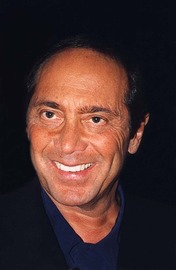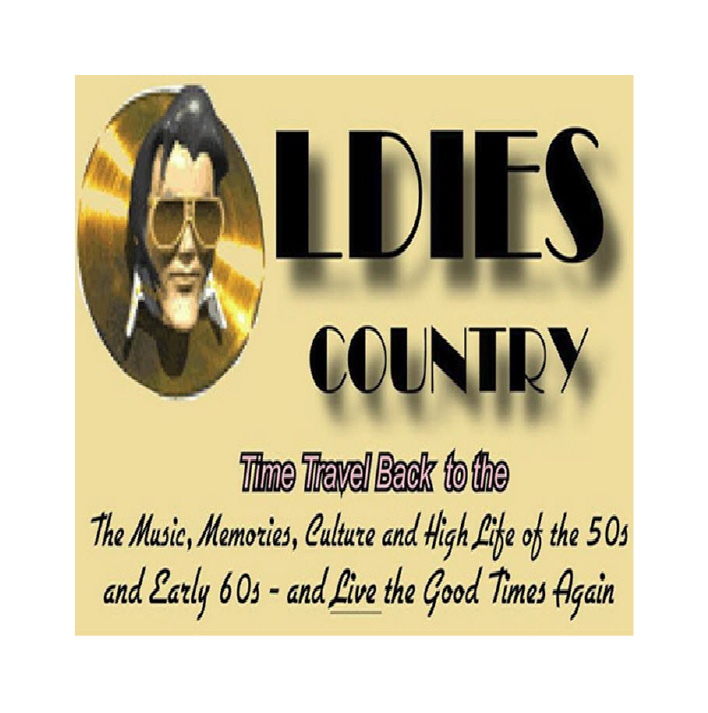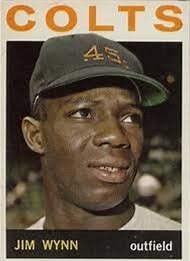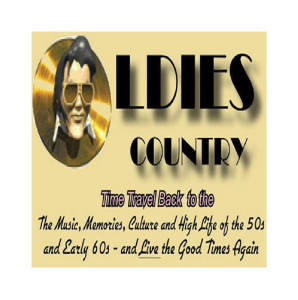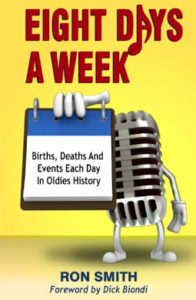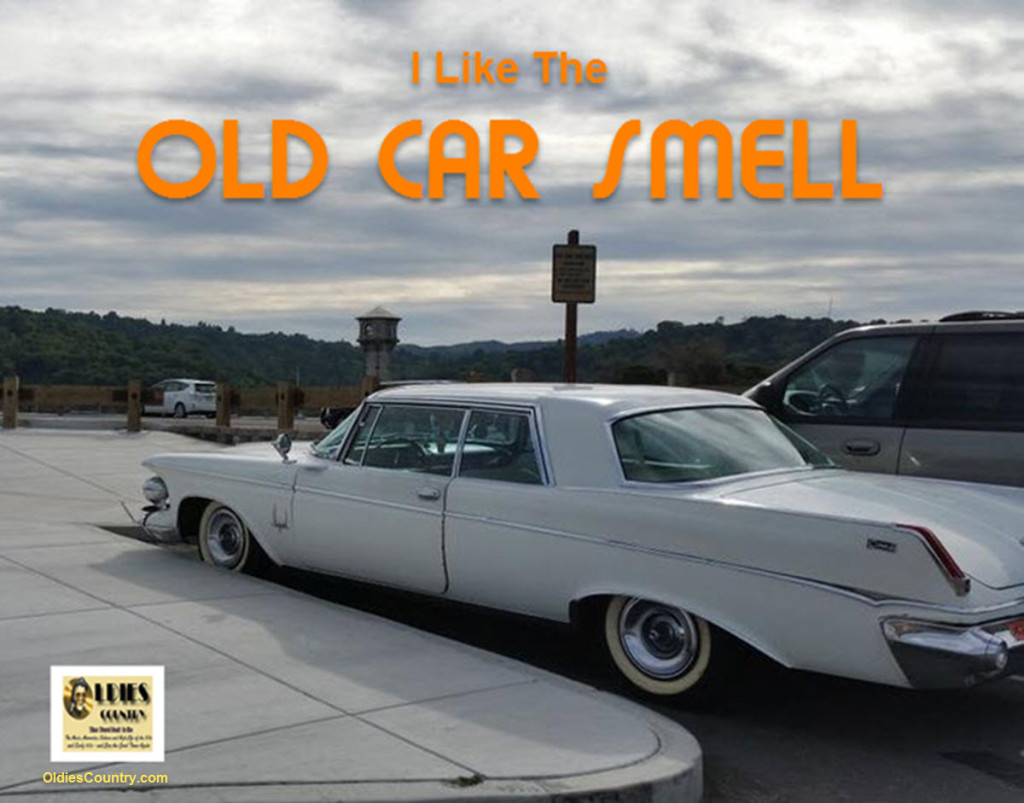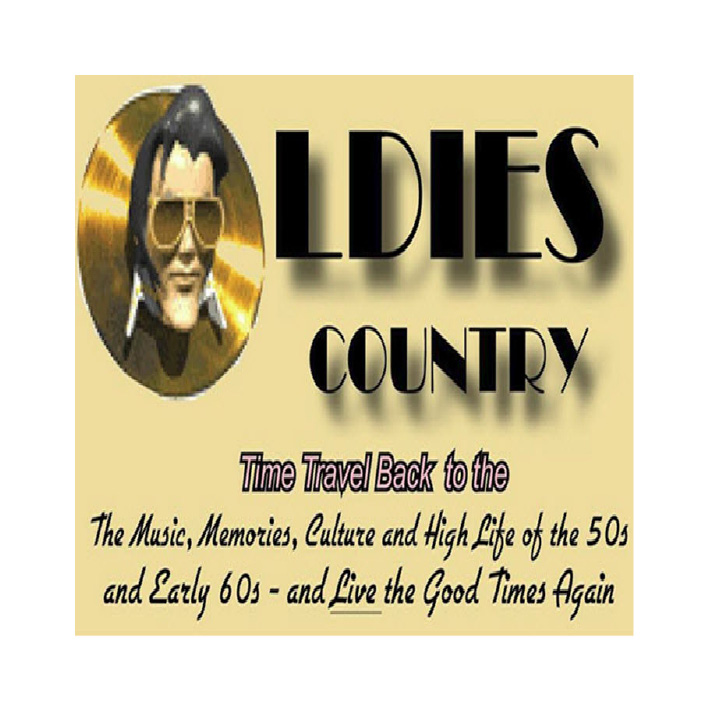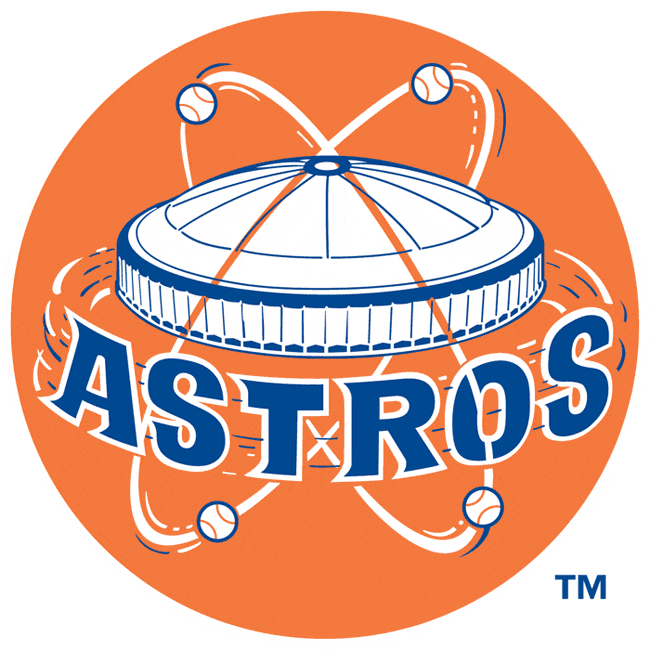
First indoor stadium with ‘exploding’ scoreboard and ‘astro-turf grass’ was reprentative of those spirited ‘1950s/early -60s’ happy days . But, the good time Camelot era would be short-lived and the Houston Astrodome, today, serves as an iconic reminder of a

Jimmy ‘The Toy Cannon’ Wynn
Houston Colt 45s/Astros first bonafide slugger passes at 78 March 26 2020. Only 5 ft 9 inches, he hit nearly 300 homers in his 15 year career, 11 with the Colt/Astros which began in 1963. MORE

happier time and place . With the recent loss of arguably the Astros first bonafide super-star, Jimmy Wynn, it’s a good time to reminisce and pay tribute to not only Wynn but a venerable landmark and the Disney-like maverick who made it happen along with many ‘firsts.’
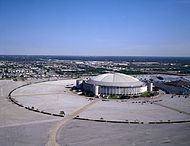
As a new, young baseball fan in 1962, there was nothing more exciting than the announcement of the world’s first indoor stadium- and a ‘spage age’ one that would be built to house Houston’s new baseball team, the Colt 45s, soon to be the ‘Astros.’
The stadium would feature a ‘space age’ electric scoreboard and the ability to regulate an indoor temperature of around 68 degrees instead of the sweltering humidity of Houston summers. Nothing like it, as maverick baseball owner Judge Roy Hofheinz broke ground in 1962 with an opening date of 1965.
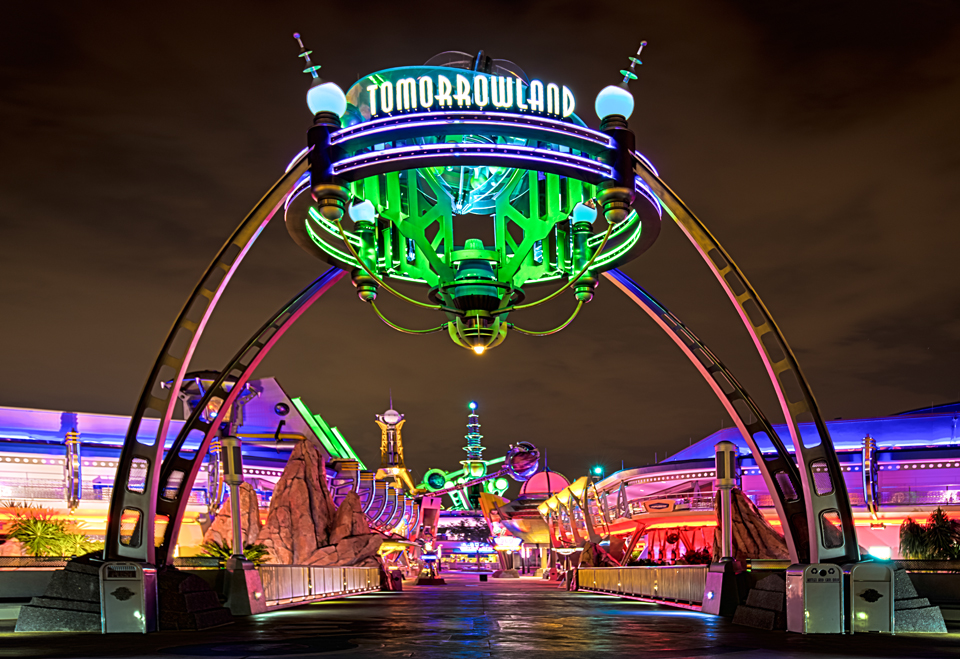
The Astrodome would be another Kennedy-era ‘spage age spectacle’ not unlike Seattle’s 1962 World’s Fair Space Needle or Los Angeles’ Disneyland amusement park, opened in 1955 but an ongoing project with futuristic additions like ‘Tomorrowland.’ It’s like the Jetsons TV show was coming to life before our eyes.
It was an exciting time to grow up, with all the post-war optimism channelled into real things. Cars with fins had become all the rage (and still are for me today with my own ’63 Chrysler Imperial). The new rock and roll music blaring from those finned-car radios at the new drive-in restaurants and movie theaters added to the good time ‘Happy Days’ feeling of this halcyon era.
But, sadly, we would find out these special times would only really last another year or two, following the shocking, assasination of a young, vital President Kennedy, who perfectly personified the aggressive, upbeat nature and values of the time.
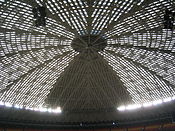
Hofheinz/Astrodome ‘Firsts’
The NRG Astrodome,[4] also known as the Houston Astrodome or simply the Astrodome, is the world’s first multi-purpose, domed sports stadium, located in Houston, Texas. Financed and assisted in development by Roy Hofheinz, mayor of Houston and known for pioneering modern stadiums. Construction on the stadium began in 1962, and it officially opened in 1965. It served as home to the Houston Astros of Major League Baseball (MLB) from its opening in 1965 until 1999, and the home to the Houston Oilers of the National Football League (NFL) from 1968 until 1996, and also the part-time home of the Houston Rockets of the National Basketball Association (NBA) from 1971 until 1975. Additionally, the Astrodome was the primary venue of the Houston Livestock Show and Rodeo from 1966 until 2002. When opened, it was named the Harris County Domed Stadium and was nicknamed ‘8th Wonder of thr World.’ (Wikapaedia)
After the original natural grass playing surface died, the Astrodome became the first major sports venue to install artificial turf, which became known as AstroTurf. In another technological first, the Astrodome featured the “Astrolite”, which was the first animated scoreboard. The Astrodome was renovated in 1988, expanding seating and altering many original features.
Obsolete in 30 Years
By the 1990s, the Astrodome was becoming obsolete. Unable to secure a new stadium, Oilers owner Bud Adams moved the team to Tennessee after the 1996 season, where they eventually became the Tennessee Titans. The Astros played at the dome through the 1999 season, before relocating to Enron Field (later changed to Minute Maid Park) in 2000, while the Houston Livestock Show and Rodeo continued to be held at the Astrodome until the opening of the adjacent NRG Stadium in 2002. Although it no longer had any primary tenants, the venue regularly hosted events during the early 2000s, and in 2005, it was used as a shelter for residents of New Orleans affected by Hurricane Katrina. The Astrodome was declared non-compliant with fire code by the Houston Fire Department in 2008 and parts of it were demolished in 2013 after several years of disuse. In 2014 it was listed on the National Register of Historic Places.[3][5]
History
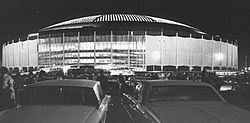
Conception
Major League Baseball expanded to Houston in 1960 when the National League agreed to add two teams. The Houston Colt .45s (renamed the Astros in 1965) were to begin play in 1962, along with their expansion brethren New York Mets. Roy Hofheinz, a former mayor of Houston, and his group were granted the franchise after they promised to build a covered stadium. It was thought a covered stadium was a must for a major league team to be viable in Houston due to the area’s subtropical climate and hot summers. Game-time temperatures are usually above 97 °F (36 °C) in July and August, with high humidity and a likelihood of rain. Hofheinz claimed inspiration for what became the Astrodome from a tour of Rome, where he learned that the builders of the ancient Colosseum installed giant velaria to shield spectators from the sun.
The Astrodome was conceived by Hofheinz as early as 1952, when he and his daughter Dene were rained out once too often at Buffalo Stadium, home of Houston’s minor league baseball team, the Houston Buffs. Hofheinz abandoned his interest in the world’s first air-conditioned shopping mall, The Galleria, and set his sights on bringing major league baseball to Houston.[6]
Design and construction
The Astrodome was designed by architects Hermon Lloyd & W. B. Morgan, and Wilson, Morris, Crain and Anderson (Morris Architects). Structural engineering and structural design was performed by Walter P Moore Engineers and Consultants of Houston. Credit[7] for the design work on the dome roof structural goes to Dr. G.R. Kiewitt and Mr. Louis O. Bass of Roof Structures, Inc. It was constructed by H. A. Lott, Inc. for Harris County. It stands 18 stories tall, covering 9.5 acres (3.8 ha). The dome is 710 feet (220 m) in diameter and the ceiling is 208 feet (63 m) above the playing surface, which itself sits 25 feet (7.6 m) below street level.[8]Astrodome Skylights
The scoreboard, eventually known as the “Astrolite“, was designed by Fair Play Scoreboards of Des Moines, Iowa.[9] Having designed the scoreboard for Dodger Stadium several years prior, team owner Roy Hofheinz was not impressed with the initial proposal for a much more generic type of scoreboard. Project designer Jack Foster teamed up with a creative professional based in Kansas City to create the first animated scoreboard. Its reported cost was $2.1 million.[9]
The Dome was completed in November 1964, six months ahead of schedule.[10] Many engineering changes were required during construction, including the modest flattening of the supposed “hemispherical roof” to cope with environmentally induced structural deformation and the use of a new paving process called “lime stabilization” to cope with changes in the chemistry of the soil. The air conditioning system was designed by Houston mechanical engineers Israel A. Naman and Jack Boyd Buckley of I. A. Naman + Associates.
Opening and reception
The multi-purpose stadium, designed to facilitate both football and baseball, is nearly circular and uses movable lower seating areas. It also ushered in the era of other fully domed stadiums, such as the Mercedes-Benz Superdome in New Orleans, as well as the now-demolished Pontiac Silverdome near Detroit, Hubert H. Humphrey Metrodome in Minneapolis, Kingdome in Seattle, and RCA Dome in Indianapolis.
To test what effect the enclosed air-conditioned environment might have on the delivery of breaking balls, Satchel Paige, in full Astros uniform, threw the first pitches at the Astrodome on February 7, 1965.[11][12] He later concluded that it was a “pitcher’s paradise”, as the lack of wind allowed for sensitive pitches to maneuver more easily.
Hofheinz had an opulent apartment in the Dome, which was removed when the facility was remodeled in 1988.[13]
On Opening Day, April 9, 1965, a sold-out crowd of 47,879 watched an exhibition game between the Houston Astros and the New York Yankees. President Lyndon B. Johnson and his wife Lady Bird were in attendance, as well as Texas Governor John Connally and Houston Mayor Louie Welch. Governor Connally tossed out the first ball for the first game ever played indoors. Dick “Turk” Farrell of the Astros threw the first pitch. Mickey Mantle had both the first hit (a single) and the first home run in the Astrodome. The Astros beat the Yankees that night, 2-1.[14]The Astrodome in 1965
President Johnson stopped at the Astrodome that evening en route to his home in Johnson City and paid his respects to baseball and Astros president Roy Hofheinz, a campaign manager for Johnson in the 1940s, just as the second inning got underway. He and Lady Bird watched the opening night game from behind the glass in Judge Hofheinz’s private box high in the right field just to the right of the giant scoreboard. LBJ ate hors d’œuvres and chicken and ice cream while watching the game.[14] “Roy, I want to congratulate you; it shows so much imagination”, he was heard to say. Later, he called the stadium “massive” and “beautiful.” Although the president’s visit overshadowed all others, dignitaries swarmed through the “Eighth Wonder of the World” during the three days of the exhibition series and for opening night against the Phillies on April 12. Chris Short of the Phillies shut out the Astros on four hits, with 12 strikeouts.[15][16]
Judy Garland First Artist to Play Astrodome
The first artist to play the Astrodome was Judy Garland on December 17, 1965, where she was paid $43,000 for the one show. The Supremes was her opening act and tickets were priced $1.00 to $7.50. The dome seated 48,000, with another 12,000 seats added for this show. Garland appeared on stage at 10 p.m. and sang for 40 minutes, with her set of songs including: “He’s Got The Whole World In His Hands”; “Just In Time”; “My Kind Of Town, Houston Is”/”Houston”; “As Long As He Needs Me”; “Joey, Joey, Joey”; “Do It Again”; “What Now My Love?”; “By Myself”; “Rock-A-Bye Your Baby”; “San Francisco”; “Chicago”; and “Over The Rainbow.” Mort Lindsey conducted.[17]
June 15, 1976 “The Rainout”Edit
The Astrodome suffered a rainout on June 15, 1976. The Astros‘ scheduled game against the Pittsburgh Pirates was called when massive flooding in the Houston area prevented all but a few fans from reaching the stadium. Both teams had arrived early for practice, but the umpires were several hours late. At 5 pm that day, with only a handful of fans on hand and already several hours behind, the umpires and teams agreed to call the game off. Tables were brought onto the field and the teams ate dinner together.[18] Although the Astros still had a home series with Pittsburgh in August, this game was made up in Pittsburgh in July.
Recent historyEdit
In 1989, four cylindrical pedestrian ramp columns were constructed outside the Dome for accessibility. This enabled the Astrodome to comply with the Americans with Disabilities Act of 1990.
GOP Convention
The 1992 Republican National Convention was held at the Astrodome in August of that year. The Astros accommodated the convention by taking a month-long road trip. A manually operated scoreboard debuted that season.
On August 19, 1995, a scheduled preseason game between the Oilers and the San Diego Chargers had to be canceled due to the dilapidated condition of the playing field. Oilers owner Bud Adams demanded a new stadium, but the city of Houston refused to fund it. After years of threats, Adams moved the team to Tennessee after the 1996 season.[19] Around that time the Astros also threatened to leave the city unless a new ballpark was built.[19] The retractable-roofed Enron Field (now known as Minute Maid Park) opened for the 2000 season in downtown Houston.
Selena Draws 66,000 Fans Prior To Her Death
One of the largest crowds in the Astrodome’s history, more than 66,746 fans, came on Sunday, February 26, 1995, to see Tejano superstar Selena and her band Los Dinos perform for a sell-out crowd during the Houston Livestock Show and Rodeo.[20] Selena y Los Dinos performed two consecutive times before at the Astrodome, breaking previous attendance records each time. This was Selena’s last televised concert before she was fatally shot on March 31, 1995 by her fan club president.NRG Park area, Houston, Texas. Astrodome, with NRG Stadium at center of this 2010 astronaut photo
The Astrodome was joined by a new neighbor in 2002, the retractable-roofed Reliant Stadium (now known as NRG Stadium), which was built to house Houston’s new NFL franchise, the Houston Texans. The Houston Livestock Show and Rodeo moved to the new venue in 2003, leaving the Astrodome without any major tenants. The last concert at the Astrodome was George Strait & the Ace in the Hole Band during the 2002 Houston Livestock Show and Rodeo, before a record crowd of 68,266; the performance was recorded in For the Last Time: Live from the Astrodome.[21]
Astrodome Becomes Home for 25,000 Hurricane Katrina Victims
Survivors of Katrina in the Astrodome, 2005
On August 31, 2005, in the wake of Hurricane Katrina, the Harris County Department of Homeland Security and Emergency Management and the State of Louisiana came to an agreement to allow at least 25,000 evacuees from New Orleans, especially those that were sheltered in the Louisiana Superdome, to move to the Astrodome until they could return home. The evacuation began on September 1, 2005. All scheduled events for the final four months of 2005 at the Astrodome were cancelled.[22] Overflow refugees were held in the surrounding Reliant Park complex. There was a full field hospital inside the Reliant Arena, which cared for the entire Katrina evacuee community.
The entire Reliant Park complex was scheduled to be emptied of hurricane evacuees by September 17, 2005. Originally, the Astrodome was planned to be used to house evacuees until December. However, the surrounding parking lots were needed for the first Houston Texans home game. Arrangements were made to help Katrina evacuees find apartments both in Houston and elsewhere in the United States. By September 16, 2005, the last of the hurricane evacuees living in the Astrodome had been moved out either to the neighboring Reliant Arena or to permanent housing north of Houston.[23] As of September 20, 2005, the remaining Katrina evacuees were relocated to Arkansas due to Hurricane Rita.[24]
Closure
In 2008, the facility was cited for numerous code violations. Since then, only maintenance workers and security guards have been allowed to enter the stadium while it is brought up to code.[25] The city council rejected demolition plans on environmental grounds, over concerns that demolition of the Dome might damage the dense development that today closely surrounds it.[26
Refurbishment plans
Numerous renovation/refurbishment plans for the dome have been presented over the years. Houston’s plan to host the 2012 Summer Olympics included renovating the Astrodome for use as a main stadium.[27] Houston became one of the USOC‘s bid finalists, but the organization chose New York City as its candidate city and the Games were ultimately awarded to London by the IOC.An aerial view of the Astrodome in 1999
Plans to convert the Astrodome into a luxury hotel were rejected.[28] A proposal to convert the Astrodome into a movie production studio was also considered but rejected.[29] Regardless of the type of renovation, all renovation plans must deal with the problem of occupancy code violations that have basically shuttered the Astrodome for the near future.[30]
In June 2013, a comprehensive plan was unveiled that would have seen the aging structure undergo an almost $200 million renovation into a multi-purpose event/convention facility. The measure would have to have been approved first through a bond election in Harris County for the publicly funded project to go forward or else, officials warned, the iconic structure would be demolished.[31] Voters ended up rejecting the measure on November 5, 2013.[32]
2013 referendum and aftermath
On November 5, 2013, voters in Houston turned down a $213 million referendum to renovate and convert the Astrodome into a state-of-the-art convention center and exhibition space known as “New Dome Experience”.[33] Until a final disposition is made, Harris County commissioners will not approve demolition of the stadium. “The building’s still there. There’s no formal plan or authorization to demolish the building, and until somebody brings such a plan to fruition, there’s a chance,” according to Willie Loston, executive director of the Harris County Sports and Convention Corporation. “The proposal was rejected by the voters. We’re back to where we were. Square one,” according to Steve Radack, Harris County commissioner.[34]
Three exterior pedestrian ramp towers were demolished on December 8, 2013. Around that time, the ramp bridges were disconnected from the main structure and the surrounding grass berms were lowered. The ticket booths were also removed along with the interior seats. The demolition was planned prior to the referendum.[35]
Historical Landmark Designation
After the failed plans of past years, the Astrodome Revitalization Project was proposed in September 2016. This plan would turn the dome into a massive underground parking garage. Specifically, the first step would raise the dome floor and use the space underneath that as parking, leaving the floor above for other uses. On September 27, 2016, the Harris County Commissioners approved the first part of the plan. This marked a major turning point for the dome, as some feared if the plan wasn’t approved the building would be demolished.[38][39][40] On January 27, 2017, the Texas Historical Commission voted unanimously to designate the dome a State Antiquities Landmark.[41] Under the designation, the Astrodome may no longer be removed, altered, damaged, salvaged, or excavated without a permit from the commission.[42] The Harris County Commissioners voted to approve a $105 million renovation plan on February 13, 2018. This plan keeps the parking garage from the Revitalization Project. Construction was set to start in October 2018 and would be completed sometime in 2020.[43] The construction start date was later moved to early 2019 and was expected to finish in 2020.[44] However, as of September 2019, the plan was put on hold with no word when construction might take place.[45] It was announced in November of 2019 that the Revitalization Project has been scrapped by Commissioners Court Judge Lina Hidalgo. Hidalgo explained that “The plan that had been designed wouldn’t have yielded truly a usable building”. As of November there has been no New plan for the Astrodome.[46]
Personal Meaning
TWENTY years ago I visited Houston on six separate occasions to see my mother, fighting for her life at MD Anderson following a bone marrow transplant for leukemia. I could see the Astrodome from the hospital window, only a half mile away. It was sad for me to see this once venerable structure sitting idly, soon to be in a fight for ITS life just like my mother. The Astros had just finished playing their last season there, having moved to the new Minute Maid Park. I wonder how long that one will last. Though My mother had been one of the longest leukemia survivors, she wouldn’t finish the year of 2001. At least the Astrodome did.
While so many iconic, pioneering structures have seen their demise at the hands of greedy developers with deeper pockets than local preservations, it’s a great pleasure to see an occasional ediface and living history like The Astrodome saved. If it weren’t for fear of demolition harming newer buildings it would have been razed years ago. Ironically,Perhaps we can thank the ‘fearful’ new buildings’ owners for preserving the Astrodome.



Last time I heard about the Astrome in the news, a few years ago, it was all but a done deal to have it demolished. The Astrodome would probably have been razed as early as 2008 if it weren’t for fear of the demolition affecting newer buildings in the area. SO it was quite a SURPRISE just researching this story to learn that the Astrodome LIVES to this day. Also surprising is that the building name, Astrodome, and team name, Astros, synonomous with another era, remain active.
the Astrodome has been through a lot in its 35 very active years and even during its last 20 mostly dormant ones. Its played host to the greatest ball players, from Jimmy Wynn to Mickey Mantle, to top artists like Judy Garland,Selena and George Straight, to the GOP convention, to Katrina victims. May the first of its kind (in many ways) palace continue to be preserved as the historical landmark for which it has deservedly been finally designated . Public tours should be given and who knows when , perhaps , a local Rennaisance could happen surrounding the Astrodome as we’ve seen in other cities.

FROM ‘STRANGE INHERITANCE’:

https://www.foxbusiness.com/features/astrodome-train-car-a-rolling-luxury-box


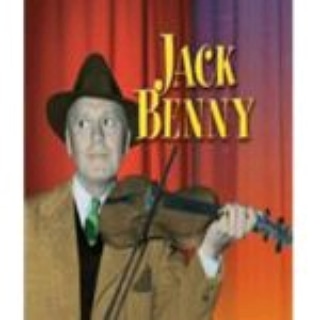
Covid -19 Positive Messages & Media, Tributes & Tips https://onlygoodnews.club/2020/03/covid-19-positive-messages-media-tributes-tips-from-some-of-our-favorites-and-not-so-famous/
